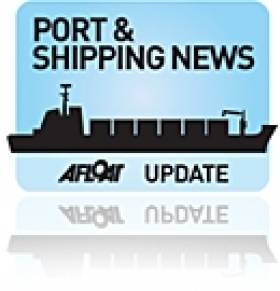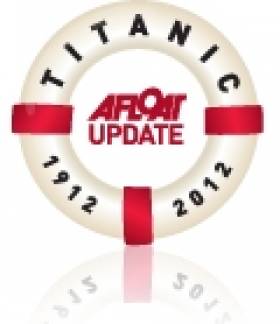Displaying items by tag: iceberg
Hydrophones Dropped Off Greenland Recording Sounds of Melting Arctic Icebergs to Fuel Irish Artist’s ‘Ocean Memory’ Project
An Irish artist is part of an international expedition that’s dropping hydrophones into the waters off Greenland to record the sounds of melting icebergs.
According to the Guardian, Siobhán McDonald will use the recordings from the underwater microphones in a mixed-media installation to explore human impact on the world’s oceans.
Over the next two years, the hydrophones will capture the sounds of melting Arctic sea ice and under subaquatic audio every hour — with the results being used both in scientific research and as part of a musical score McDonald will create with a composer.
My floating studio on expedition in the deepest part of the Greenland ocean. Just passed the awesome Greenland glacier yesterday. #arctic #water #northernlights #painting pic.twitter.com/Mk8sxSgh9W
— Siobhan McDonald (@SioMcDonald) October 11, 2022
“I’m interested in hearing the acoustic pollution,” the artist says. “The sea levels are rising and that will have an impact I’d imagine on the sound range and on all the biodiversity.
“Sound is fundamental in the ocean and Arctic animals. Hearing is fundamental to communication, breeding, feeding and ultimately survival. It speaks of the necessity of paying attention to the pollution we are causing to the ecosystems around us.”
The Guardian has much more on the story HERE.
A giant iceberg that snapped off Antarctica’s Larsen-C ice shelf some three and a half years ago shrank towards the end of its drift across the Southern Ocean, but released 152 billion tonnes of freshwater.
The European Space Agency (ESA) says scientists have charted the fate of A-68A, which had a surface area of more than twice the size of Luxemburg – one of the largest icebergs on record.
Antarctic icebergs are named from the Antarctic quadrant in which they were originally sighted, then a sequential number, and then if the iceberg breaks, a sequential letter is added.
For the first two years of its life, A-68A stayed in the cold waters of the Weddell Sea close to its parent ice shelf, where it experienced little in the way of melting, according to the ESA.
However, once the berg began its northward journey across the Drake Passage, it travelled through increasingly warm waters and began to melt.
 The A-68 iceberg journey
The A-68 iceberg journey
To track how the area of A-68A changed, scientists drew on imagery from five satellites. The newly published study says that A-68A collided only briefly with the seafloor and broke apart shortly afterwards, making it less of a risk in terms of blockage.
By the time it reached the shallow waters around South Georgia, the iceberg’s keel had reduced to 141 metres below the ocean surface, shallow enough to just avoid the seabed which is around 150 metres deep.
“If an iceberg’s keel is too deep it can get stuck on the seafloor. This can be disruptive in many ways; the scour marks can destroy fauna, and the berg itself can block ocean currents and predator foraging routes,” the ESA says.
“However, a side effect of the melting was the release of a colossal 152 billion tonnes of freshwater close to the island – a disturbance that could have a profound impact on the island’s marine habitat,” it says.
World's Largest Iceberg Calves in Antarctica
The European Space Agency (ESA) has confirmed a satellite recording of what may be the world's largest iceberg - slightly larger than the Spanish island of Mallorca.
The ESA says the iceberg was spotted by the British Antarctic Survey and confirmed from the US National Ice Centre with Copernicus Sentinel-1 imagery.
Named A-76, the berg measures around 170 km in length and 25 km wide, and has calved from the western side of the Ronne Ice Shelf, lying in Antarctica's Weddell Sea.
The ESA explains that icebergs are traditionally named from the Antarctic quadrant in which they were originally sighted, then a sequential number, then, if the iceberg breaks, a sequential letter.
"The enormity of the berg makes it the largest in the world, snatching first place from the A-32A iceberg - approximately 3880 sq km in size - which is also located in the Weddell Sea," the ESA says.
An iceberg named A-74 which broke off the Brunt Ice Shelf in February 2021 was only 1270 sq km, it says
An enormous iceberg estimated at about one-and-a-half times the size of greater Paris has broken off in Antarctica.
The European Space Agency (ESA) says radar images from the Copernicus Sentinel-1 mission show the 1270 square kilometre iceberg breaking free from the northern section of Antarctica’s Brunt ice shelf last Friday.
The ESA says glaciologists had been closely monitoring the many cracks and chasms that have formed in the 150 m thick Brunt ice shelf in recent years.
A new crack was spotted in late 2019 on an area of the shelf north of the McDonald Ice Rumples, and it was reported to be “heading towards another large crack” located close to the Stancomb-Wills glacier tongue, the ESA says.
 Radar images from the Copernicus Sentinel-1 mission show the 1270 square kilometre iceberg breaking free from the northern section of Antarctica’s Brunt ice shelf
Radar images from the Copernicus Sentinel-1 mission show the 1270 square kilometre iceberg breaking free from the northern section of Antarctica’s Brunt ice shelf
“Although the calving of the new berg was expected and forecasted some weeks ago, watching such remote events unfold is still captivating,” Mark Drinkwater of the ESA has said.
“Over the following weeks and months, the iceberg could be entrained in the swift south-westerly flowing coastal current, run aground or cause further damage by bumping into the southern Brunt ice shelf,” he said.
“So we will be carefully monitoring the situation using data provided by the Copernicus Sentinel-1 mission,” he said, referring to the mission run by the ESA.
The iceberg has been informally dubbed “A-74” by glaciologists.
Antarctic icebergs are named from the Antarctic quadrant in which they were originally sighted, then a sequential number. If the iceberg breaks, a sequential letter is then added.
The ESA says the calving does not pose a threat to the presently unmanned British Antarctic Survey’s Halley VI Research station, which was relocated in 2017 after the ice shelf was assessed as unsafe.
Giant Antarctic Iceberg Poses Threat To Shipping
#Shipping - Shipping routes south of the Equator could be threatened by a giant iceberg the size of New York's Manhattan Island that's broken off a glacier in Antarctica.
BBC News reports that a British research team has been tasked with tracking the massive ice floe, which broke free from the Pine Island Glacier in July and is now drifting in the Southern Ocean between New Zealand and Chile.
A previous iceberg in the same area drifted into the Drake Passage between Cape Horn and the South Shetland Islands, and if the new discovery took the same trajectory it could pose a serious threat to international shipping lanes.
BBC News has much more on the story HERE.
Tennis Duo's Untold Titanic Story
#TITANIC - The Irish Times has highlighted "one of the less well-known tales of the disaster" of the Titanic, regarding two tennis champions who went on to enter that sport's hall of fame.
The story of Richard Williams and Lark Behr was told at an exhibition of sporting memorabilia in Yorkshire last month by collector Robert Fuller.
Williams, who was 21 at the time, was headed to the US Championships when the Titanic went down. He was among those rescued by the Carpathia after hours in frozen water, and fought with that ship's doctor who wanted to amputate his legs.
His persistence paid off, as just months later he was in the quarter finals of the US Open, a context he would win in 1914 and 1916, not to mention the Wimbledon doubles title in 1920 and Olympic gold in the mixed doubles in 1924.
Behr - who reportedly proposed to his fiancée on a lifeboat - also had a glittering career after the tragedy, reaching the doubles final at Wimbledon and number three in the US rankings.
Meanwhile, BBC News has posted an infographic that follows in detail the critical moments leading up to and after the Titanic struck the iceberg that sealed its doom at 11.40pm on Sunday 14 April 1912.

























































